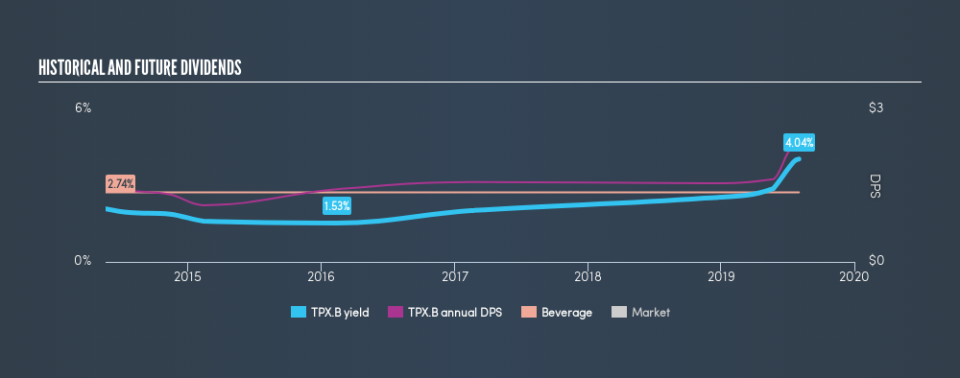Is Molson Coors Canada Inc. (TSE:TPX.B) A Great Dividend Stock?

Dividend paying stocks like Molson Coors Canada Inc. (TSE:TPX.B) tend to be popular with investors, and for good reason - some research suggests a significant amount of all stock market returns come from reinvested dividends. On the other hand, investors have been known to buy a stock because of its yield, and then lose money if the company's dividend doesn't live up to expectations.
With a goodly-sized dividend yield despite a relatively short payment history, investors might be wondering if Molson Coors Canada is a new dividend aristocrat in the making. We'd agree the yield does look enticing. There are a few simple ways to reduce the risks of buying Molson Coors Canada for its dividend, and we'll go through these below.
Click the interactive chart for our full dividend analysis
Payout ratios
Dividends are usually paid out of company earnings. If a company is paying more than it earns, then the dividend might become unsustainable - hardly an ideal situation. So we need to form a view on if a company's dividend is sustainable, relative to its net profit after tax. In the last year, Molson Coors Canada paid out 30% of its profit as dividends. This is a medium payout level that leaves enough capital in the business to fund opportunities that might arise, while also rewarding shareholders. Plus, there is room to increase the payout ratio over time.
We also measure dividends paid against a company's levered free cash flow, to see if enough cash was generated to cover the dividend. Molson Coors Canada paid out 169% of its free cash flow last year, suggesting the dividend is poorly covered by cash flow. Paying out more than 100% of your free cash flow in dividends is generally not a long-term, sustainable state of affairs, so we think shareholders should watch this metric closely. Molson Coors Canada paid out less in dividends than it reported in profits, but unfortunately it didn't generate enough free cash flow to cover the dividend. Cash is king, as they say, and were Molson Coors Canada to repeatedly pay dividends that aren't well covered by cashflow, we would consider this a warning sign.
Is Molson Coors Canada's Balance Sheet Risky?
As Molson Coors Canada has a meaningful amount of debt, we need to check its balance sheet to see if the company might have debt risks. A quick check of its financial situation can be done with two ratios: net debt divided by EBITDA (earnings before interest, tax, depreciation and amortisation), and net interest cover. Net debt to EBITDA measures total debt load relative to company earnings (lower = less debt), while net interest cover measures the ability to pay interest on the debt (higher = greater ability to pay interest costs). With a net debt to EBITDA ratio of 16.16 times, Molson Coors Canada is very highly levered. While this debt might be serviceable, we would still say it carries substantial risk for the investor who hopes to live on the dividend.
Net interest cover can be calculated by dividing earnings before interest and tax (EBIT) by the company's net interest expense. With EBIT of less than 1 times its interest expense, Molson Coors Canada's financial situation is potentially quite concerning. Readers should investigate whether it might be at risk of breaching the minimum requirements on its loans. Low interest cover and high debt can create problems right when the investor least needs them, and we're reluctant to rely on the dividend of companies with these traits.
We update our data on Molson Coors Canada every 24 hours, so you can always get our latest analysis of its financial health, here.
Dividend Volatility
From the perspective of an income investor who wants to earn dividends for many years, there is not much point buying a stock if its dividend is regularly cut or is not reliable. Molson Coors Canada has been paying a dividend for the past five years. During the past five-year period, the first annual payment was US$1.46 in 2014, compared to US$2.24 last year. Dividends per share have grown at approximately 8.9% per year over this time. The growth in dividends has not been linear, but the CAGR is a decent approximation of the rate of change over this time frame.
Dividends have grown at a reasonable rate, but with at least one substantial cut in the payments, we're not certain this dividend stock would be ideal for someone intending to live on the income.
Dividend Growth Potential
With a relatively unstable dividend, it's even more important to see if earnings per share (EPS) are growing. Why take the risk of a dividend getting cut, unless there's a good chance of bigger dividends in future? Molson Coors Canada's earnings per share are up 198% on last year. We're glad to see EPS up on last year, but we're conscious that growth rates typically slow as companies increase in size. With high earnings per share growth in recent times and a modest payout ratio, we think this is an attractive combination if earnings can be reinvested to generate further growth. We do note though, one year is too short a time to be drawing strong conclusions about a company's future prospects.
Conclusion
Dividend investors should always want to know if a) a company's dividends are affordable, b) if there is a track record of consistent payments, and c) if the dividend is capable of growing. First, we like Molson Coors Canada's low dividend payout ratio, although we're a bit concerned that it paid out a substantially higher percentage of its free cash flow. Unfortunately, the company has not been able to generate earnings per share growth, and cut its dividend at least once in the past. Ultimately, Molson Coors Canada comes up short on our dividend analysis. It's not that we think it is a bad company - just that there are likely more appealing dividend prospects out there on this analysis.
See if management have their own wealth at stake, by checking insider shareholdings in Molson Coors Canada stock.
Looking for more high-yielding dividend ideas? Try our curated list of dividend stocks with a yield above 3%.
We aim to bring you long-term focused research analysis driven by fundamental data. Note that our analysis may not factor in the latest price-sensitive company announcements or qualitative material.
If you spot an error that warrants correction, please contact the editor at editorial-team@simplywallst.com. This article by Simply Wall St is general in nature. It does not constitute a recommendation to buy or sell any stock, and does not take account of your objectives, or your financial situation. Simply Wall St has no position in the stocks mentioned. Thank you for reading.

